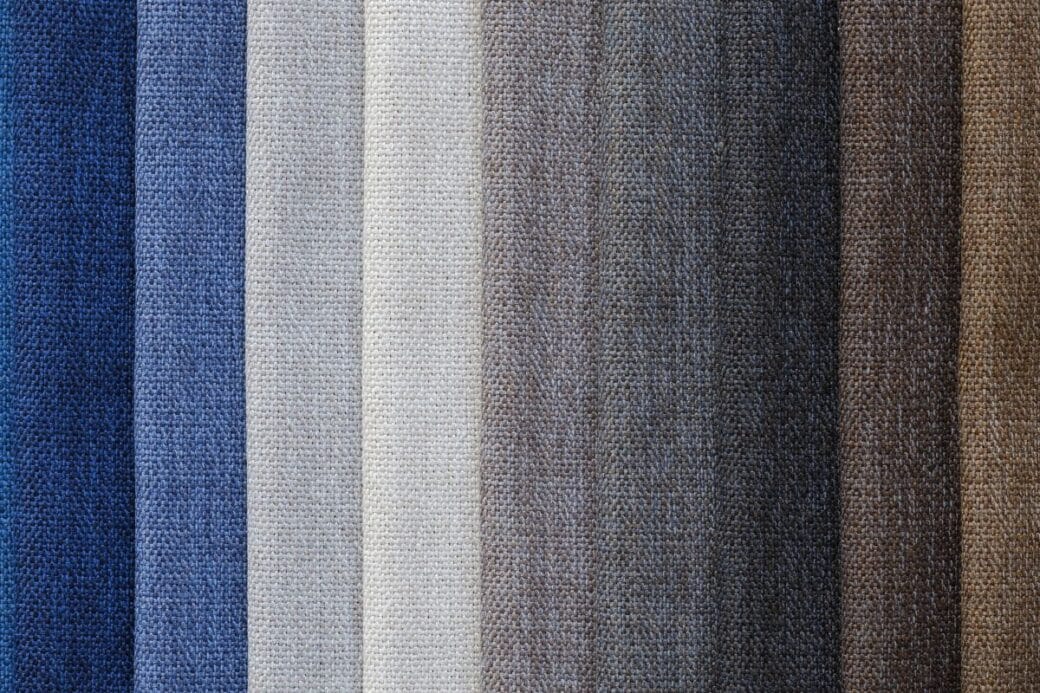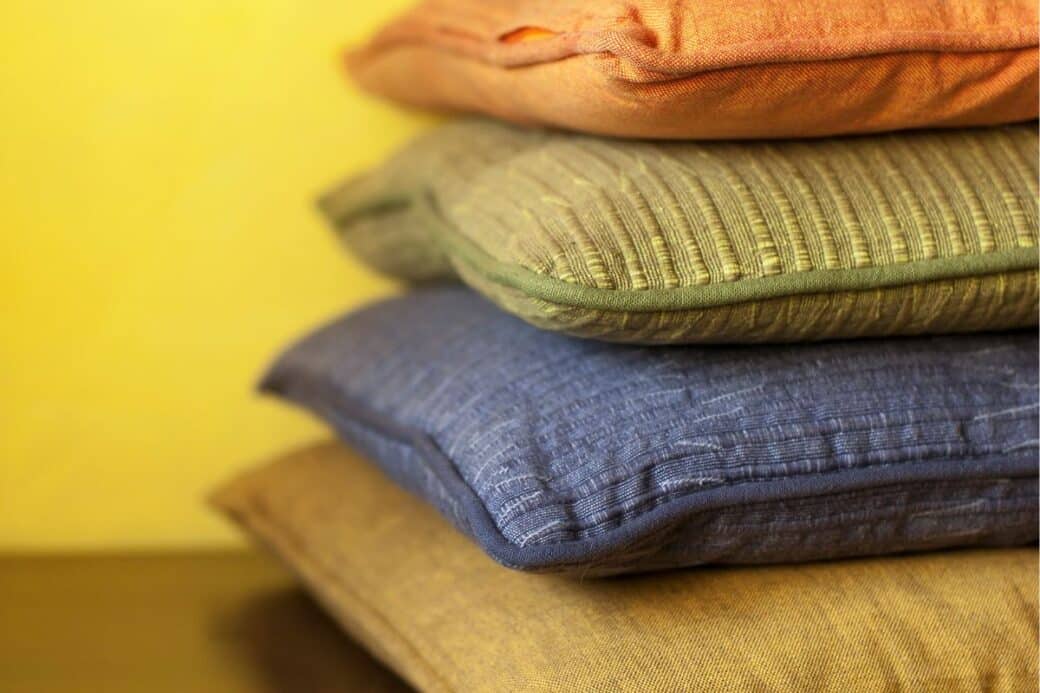Are you on a quest to find the perfect fabric for your meditation cushion? Look no further, as we invite you to embark on an exciting exploration of meditation cushion fabrics. From plush velvet to eco-friendly cotton, each fabric offers its unique blend of comfort and style. Join us as we delve into the world of meditation cushion fabrics, uncovering the key features and benefits that will guide you on your journey to zen-like comfort.

Meditation Cushion Fabrics: Understanding Meditation Cushions
Meditation cushions are essential tools for practitioners to maintain proper posture and support during meditation sessions. They provide comfort, stability, and alignment, allowing you to fully focus on your practice. These cushions come in various shapes, sizes, and materials, each offering unique benefits and qualities. In this article, we will explore the different types of meditation cushions, the importance of material selection, and tips for choosing the right cushion for your practice.
About Meditation Cushions
Meditation cushions, also known as zafus or zabutons, are specifically designed to provide a comfortable and supportive seat for meditation. Traditional zafus are round, elevated cushions filled with natural fibers, while zabutons are rectangular mats that go underneath the zafu for additional cushioning and insulation. Together, they create a stable and comfortable foundation for your meditation practice.
Importance of Material in Meditation Cushions
The material of a meditation cushion plays a crucial role in determining its comfort, durability, and sustainability. Different materials offer different qualities, so it is essential to understand the benefits and drawbacks of each option before making a choice. Factors such as breathability, hypoallergenic properties, and environmental impact should be considered when selecting a meditation cushion material.
Common Types of Meditation Cushions
- Cotton Meditation Cushions
Cotton meditation cushions are a popular choice for practitioners due to their softness, breathability, and affordability. They provide a supportive yet comfortable seat, allowing for extended periods of meditation without discomfort. Cotton cushions are available in various shapes and sizes to accommodate different body types and preferences.
Benefits of Cotton Meditation Cushions
Cotton meditation cushions offer several advantages. Firstly, they are hypoallergenic, making them suitable for practitioners with sensitivities or allergies. Secondly, cotton is a natural, breathable material that allows for proper air circulation, preventing the build-up of heat and moisture during meditation. Furthermore, cotton cushions are easy to maintain, as they can be machine washed or spot cleaned.
Tips for Maintaining Cotton Meditation Cushions
To prolong the lifespan of your cotton meditation cushion, it is recommended to regularly fluff and reshape it to ensure even distribution of the filling. If your cushion has a removable cover, washing it according to the care instructions will help keep it clean and fresh. Additionally, storing your cotton cushion in a cool, dry place away from direct sunlight will prevent any potential damage or discoloration.
Finding the Right Cotton Meditation Cushion for You
When choosing a cotton meditation cushion, consider factors such as your body size, preferred sitting height, and personal comfort level. Some cushions have adjustable buckles or straps to customize the height, while others come in standard sizes. It is advisable to test different cushions to ensure proper support and comfort before making a purchase.
- Silk Meditation Cushions
Silk meditation cushions are a luxurious and aesthetically pleasing option for practitioners seeking a touch of elegance in their meditation space. The smooth and soft texture of silk provides a comfortable seat, allowing for a serene and calming meditation experience. However, it is essential to consider both the pros and cons before investing in a silk cushion.
Pros and Cons of Silk Meditation Cushions
Silk meditation cushions offer a unique blend of comfort and visual appeal. Silk is a natural insulator, keeping you warm in colder climates and cool in warmer weather. Its smooth texture prevents friction and discomfort during extended meditation sessions. However, silk cushions tend to be more expensive compared to other materials, and they may require delicate care to maintain their luxurious appearance.
Silk Meditation Cushion Care Instructions
To maintain the pristine look and feel of a silk meditation cushion, it is recommended to avoid exposing it to direct sunlight, as this can cause fading and damage. Spills or stains should be gently spot cleaned with a mild detergent and warm water. Dry cleaning is generally the preferred method for silk cushions, but always follow the manufacturer’s care instructions to ensure proper maintenance.
Aesthetic Appeal of Silk Meditation Cushions
Silk meditation cushions add a visual touch of elegance and sophistication to any meditation space. The smooth and shiny texture of silk, combined with the wide range of vibrant colors and patterns available, allows practitioners to create a serene and visually appealing environment for their meditation practice. As the saying goes, beauty can be found in the details, and silk cushions certainly contribute to a more aesthetically pleasing experience.
- Hemp Meditation Cushions
Hemp meditation cushions offer a sustainable and eco-friendly option for environmentally conscious practitioners. Hemp is a highly renewable resource that requires minimal water and pesticides to cultivate. The natural fibers of hemp provide a firm yet comfortable seat, allowing for proper alignment and posture during meditation.
The Sustainability of Hemp Cushions
Hemp is considered one of the most sustainable and environmentally friendly fabrics available. It grows quickly without depleting soil nutrients, and its deep roots prevent soil erosion. Additionally, hemp cultivation requires less water compared to other crops, making it an ideal choice for those concerned about water conservation. By choosing a hemp meditation cushion, you are actively supporting sustainable practices and reducing your carbon footprint.
Comfort Level of Hemp Meditation Cushions
Hemp cushions offer a firm and supportive seat, promoting proper alignment and posture during meditation. The natural fibers of hemp allow for breathability, preventing overheating and discomfort. Additionally, hemp cushions tend to be more durable and long-lasting compared to other materials, ensuring many years of comfortable meditation sessions.
How to Clean and Store Hemp Meditation Cushions
Cleaning hemp meditation cushions is relatively simple. In most cases, spot cleaning with a mild detergent and warm water is sufficient to remove stains or spills. It is essential to allow the cushion to air dry completely before storing it to prevent the development of mold or mildew. When storing, ensure the cushion is kept in a cool, dry place away from direct sunlight or extreme temperatures.
- Buckwheat Hull Meditation Cushions
Buckwheat hull meditation cushions provide a unique and supportive seating option for practitioners. Buckwheat hulls are the hard, outer casings of the buckwheat seed and offer a natural weight distribution and firmness that promotes proper spinal alignment during meditation. This type of cushion is highly customizable, allowing practitioners to adjust the filling to their preferred comfort level.
Explanation of Buckwheat Hulls
Buckwheat hulls are the outer husks of the buckwheat seed, which are removed during the milling process. They are small, lightweight, and uniquely shaped, providing excellent support and allowing air circulation within the cushion. The combination of buckwheat hulls and a cotton or silk cover creates a comfortable and moldable seat that conforms to your body shape.
Advantages of Buckwheat Hull Meditation Cushions
Buckwheat hull cushions offer several advantages. Firstly, they provide firm support while conforming to the shape of your body, ensuring proper alignment and reducing the risk of discomfort or pain during meditation. Additionally, the hulls allow for air circulation, preventing the build-up of heat and moisture. The customizable nature of buckwheat hull cushions also allows practitioners to adjust the filling to their desired comfort level.
Potential Downsides of Buckwheat Hull Cushions
While buckwheat hull cushions offer excellent support, they may not be suitable for everyone. Some practitioners may find the texture of the hulls uncomfortable, especially during longer meditation sessions. Additionally, buckwheat hulls tend to settle over time and may require occasional refilling to maintain their optimal support.
- Kapok Meditation Cushions
Kapok meditation cushions provide a unique combination of comfort, support, and eco-friendliness. Kapok is a natural fiber derived from the seed pods of the kapok tree. It is lightweight, hypoallergenic, and offers excellent insulation, making it a popular choice for practitioners seeking a sustainable and comfortable meditation cushion.
Overview of Kapok Material
Kapok is a soft, silky fiber that comes from the seed pods of the kapok tree. It is an excellent alternative to synthetic materials, as it is renewable, biodegradable, and requires minimal processing. Kapok fibers have a hollow structure, allowing for natural insulation and breathability. The combination of kapok and a cotton or silk cover creates a cushion that offers support, comfort, and sustainable qualities.
Why Choose a Kapok Meditation Cushion?
Kapok cushions provide a comfortable and supportive seat for meditation. The soft and plush nature of kapok fibers allows for gentle sinking and molding to your body shape, promoting relaxation and ease during your practice. Furthermore, kapok is hypoallergenic, making it a suitable choice for practitioners with allergies or sensitivities.
Care for Kapok Meditation Cushions
To maintain the integrity and longevity of a kapok meditation cushion, it is essential to regularly fluff and reshape it to prevent the fibers from compressing. If the cushion has a removable cover, follow the manufacturer’s instructions for cleaning, as kapok can clump if exposed to moisture. It is recommended to store kapok cushions in a cool, dry place away from direct sunlight to prevent any potential damage or discoloration.
- Memory Foam Meditation Cushions
Memory foam meditation cushions offer a unique combination of comfort and support by conforming to the shape of your body. Memory foam is a synthetic material known for its ability to retain its shape and provide pressure relief. While it may not be the most sustainable option, memory foam cushions are highly regarded for their comfort and ergonomic benefits.
Benefits of Memory Foam Cushions
Memory foam cushions are praised for their exceptional comfort and support. The foam molds to the contours of your body, evenly distributing weight and relieving pressure points. This can help reduce discomfort and improve posture during meditation. Additionally, memory foam cushions provide excellent shock absorption, making them ideal for practitioners with joint pain or sensitivity.
Potential Issues with Memory Foam Cushions
One of the primary concerns with memory foam cushions is their environmental impact. Most memory foam is made from petroleum-based chemicals and does not biodegrade easily. However, some manufacturers offer eco-friendly alternatives that use plant-based materials or incorporate recycled foam. It is also important to note that memory foam cushions may retain heat, potentially causing discomfort during longer meditation sessions.
Caring for a Memory Foam Meditation Cushion
To maintain the quality and extend the lifespan of a memory foam meditation cushion, it is crucial to follow the manufacturer’s care instructions. Memory foam cushions are generally not machine washable and should be spot cleaned with a mild detergent if necessary. Ensure the cushion is completely dry before using or storing it to prevent the growth of mold or mildew.

Choosing the Right Fabric
When selecting a meditation cushion fabric, there are several factors to consider to ensure your comfort and satisfaction. Understanding your personal preferences, body type, and any specific requirements will guide your decision-making process. Additionally, consulting cushion reviews and product descriptions can provide valuable insights into the performance, durability, and comfort of different fabrics.
Factors to Consider When Selecting a Cushion Fabric
When choosing a fabric for your meditation cushion, consider factors such as texture, breathability, and durability. Some individuals may prefer a smooth and soft surface, while others may benefit from a more textured or grippy fabric. Breathability is crucial to prevent discomfort and overheating, especially during longer meditation sessions. Lastly, durability is essential to ensure the cushion withstands regular use and maintains its shape and support over time.
Understanding Your Own Meditation Needs
Your personal preferences and meditation style play a significant role in selecting the right fabric for your cushion. If you tend to get warm easily, choosing a fabric with excellent breathability, such as cotton or hemp, may be beneficial. For practitioners seeking a more plush and comfortable seat, memory foam or kapok cushions may be suitable. Reflecting on your own needs and preferences will guide you towards the fabric that best supports your meditation practice.
Consulting Cushion Reviews and Product Descriptions
Reading reviews and product descriptions from fellow practitioners can provide valuable insights into the comfort, quality, and durability of different fabric options. Real-life experiences and testimonials can help you make a more informed decision and ensure you choose a cushion fabric that aligns with your specific meditation requirements. Be sure to consider the overall rating, as well as any specific comments or feedback about the fabric.
Fabric Care and Maintenance
Taking proper care of your meditation cushion is essential to maintain its cleanliness, performance, and longevity. General maintenance tips, understanding care labels, and dealing with stubborn stains will help you ensure that your cushion remains fresh and supportive throughout its lifespan.
General Tips for Cushion Maintenance
Regular maintenance of your meditation cushion will help preserve its shape and comfort. Fluffing and reshaping the cushion regularly, especially after prolonged use, will prevent the filling from becoming compressed and uneven. It is also advisable to rotate the cushion occasionally to distribute the pressure evenly. Additionally, avoiding sharp objects or exposing the cushion to extreme temperatures will help prevent any damage.
Understanding Care Labels
Most meditation cushions come with care labels that provide instructions on how to clean and maintain the fabric. It is crucial to carefully read and follow these guidelines to avoid potential damage or discoloration. Some fabrics may be machine washable, while others may require spot cleaning or professional dry cleaning. Understanding the care labels will ensure that you clean your cushion effectively and without causing any harm.
Dealing with Stubborn Stains
Accidents happen, and sometimes stains may occur on your meditation cushion. For most fabric types, gently spot cleaning with a mild detergent and warm water is sufficient to remove light stains. It is essential to avoid rubbing or scrubbing vigorously, as this may damage the fabric fibers. Stubborn stains, such as ink or oil, may require professional cleaning or specialized stain removal techniques. Consult a professional cleaner or follow the manufacturer’s recommendations for best results.
Comfort vs. Sustainability in Fabric Choice
Finding the balance between comfort and sustainability is a crucial consideration when selecting a fabric for your meditation cushion. While comfort is paramount to your meditation practice, it is also essential to be mindful of the environmental impact of your choices. Exploring recycled and organic cushion options and supporting sustainable manufacturing practices can help you align your comfort needs with your commitment to eco-friendliness.
Balancing Comfort and Eco-Friendliness
Comfort and eco-friendliness are not mutually exclusive when it comes to meditation cushion fabrics. Many manufacturers offer a range of sustainable options made from recycled materials or organic fibers. Utilizing recycled and organic fabrics reduces the demand for new resources and minimizes waste. By prioritizing comfort and eco-friendliness, you can contribute to a more sustainable future while enjoying the benefits of a supportive meditation cushion.
Exploring Recycled and Organic Cushion Options
Recycled fabrics, such as those made from recycled plastic bottles or post-consumer waste, offer an innovative and sustainable choice for meditation cushions. These materials, when properly processed, can provide excellent support and comfort while reducing environmental impact. Organic fabrics, on the other hand, are made from natural fibers grown without the use of harmful pesticides or synthetic fertilizers. Exploring cushions made from recycled or organic materials allows you to make a conscious choice that aligns with your values.
Impact of Your Cushion Choice on Your Meditation Practice
Ultimately, the fabric choice of your meditation cushion can have a significant impact on your overall meditation experience. A comfortable and supportive cushion allows you to maintain proper posture and alignment, enabling you to focus more effectively on your practice. By selecting a sustainable fabric, you can practice mindfulness not only on the cushion but also in your choices as a consumer. The alignment of comfort, sustainability, and your meditation practice creates a harmonious connection between self-care and environmental stewardship.
In conclusion, understanding the different types of meditation cushion fabrics and their unique qualities is essential for selecting the right cushion for your meditation practice. Whether you choose cotton for its affordability and softness, silk for its elegance and visual appeal, hemp for its sustainability and durability, buckwheat hulls for their support and moldability, kapok for its comfort and eco-friendliness, or memory foam for its contouring and pressure relief, you can find a fabric that suits your needs. By considering factors such as fabric care, comfort vs. sustainability, and personal preferences, you can make an informed decision that enhances your meditation experience while being mindful of the environment.




